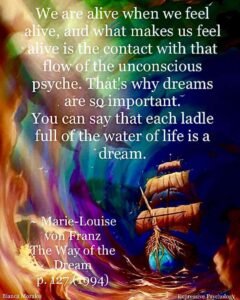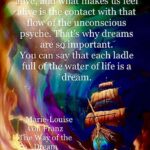
In her brilliant book, “Psychic Energy,” Jungian analyst M. Esther Harding writes: “When life presents us with a new problem, a new chapter of experience for which the old adaptation is inadequate, it is usual to experience a withdrawal of the libido. For one phase of life has come to an end, and that which is needed for the new is not immediately at hand. This withdrawal will be experienced in consciousness as a feeling of emptiness, often of depression, and certainly of inertia, with an overtone of self-rebuke because of what seems like laziness or sloth.”
Have you ever been there? I have. Many times. And each time it happens it takes a while before I remember that this is simply another step in the journey. The road may be leading downhill for now, but it’s still there, and as long as I can place one foot in front of the other the story isn’t over yet. But what are we to do while we’re in the abyss of emptiness? The depths of depression? The islands of inertia? The swamps of self-rebuke?
First of all, we need to remember that when our libido, or psychological energy, withdraws, it is not gone forever. The laws of physics tell us that energy can be transformed but not destroyed. When we feel a loss of energy it simply means that the energy which was formerly available to our ego has sunk into the unconscious. Once it gets there, forces over which our egos have no control will have to be mobilized before the energy can return to consciousness. The ego usually feels to blame, but it is not, because it has no control over unconscious forces.
Second, in the words of Harding, “When the light of life dims and one is left in the darkness of depression, it is much more effective to turn for the moment from the objective task and to concentrate attention on what is going forward within, instead of forcing oneself to continue by a compulsive effort of the will.” Once the libido is no longer available to our ego, will power can only be used effectively to “follow the lost energy into the hidden places of the psyche by means of creative introversion.”
Creative introversion means working with our fantasies and dreams in creative ways that feel meaningful. These products of our unconscious speak to the hidden forces which have sucked our libido down into the dark belly of the whale, and their images can give us clues not only to the nature of the difficulty, but also to the solution.
For example, many years ago toward the end of an extended period of libido loss I kept imagining myself as a baby chick still inside an egg, pecking at the shell. I knew I felt trapped, but I didn’t know what was trapping me or how to get out. Exploring this and other waking and dreaming images through art, journaling and dreamwork highlighted features of my persona that had initially protected the new life in me but were beginning to smother it. As I kept pecking away, cracks appeared in my shell until it finally collapsed and I stepped out of my self-imposed prison. The extraordinary infusion of new life I’ve experienced since then has taught me to see libido loss and depression not as obstacles or enemies, but as helpful guides along the way.
My thanks to Dr. Judith Rich for the inspiration for this post. Check out her article on the Huffington Post to see her wonderful take on a related topic.
Healing the Sacred Divide can be found at Amazon and Larson Publications, Inc. Ebook versions of The Bridge to Wholeness and Dream Theatres of the Soul are at Amazon, Kobo, Barnes and Noble, Smashwords, and Diesel Ebooks

A Lesson on Aging
I’m so happy to be back in the mountains. I love the weather, the trees, the birds, the rushing creek, the flowering bushes. The beauty.





18 Responses
Jeannie- Once again, your message is SO timely.
CC
Yayyy! I like thinking that our souls are carrying on their own meaningful dialogue well beneath the awareness of our ego selves and that the content of their conversation appears here from time to time. I think this happens often between people who are connected at a soul level. Blessings.
Beautiful…thank you. And your imagery of the baby chick is wonderful. Imagine if we were all able to find our particular imagery each time we move through this death and rebirth process? Your work is so helpful to each of us as we move into/through healing.
Once I’m finished with this semester, I plan on returning to a WIP titled “Joy in the Valley of the Shadow” which discusses my personal perceptions of transition and transformation (melancholy, depression, suicide, death). This post is so appropriate to that theme. And I will add the book you mentioned to my reading list.
Blessings!
Hi Darla, I’m glad to know this speaks to you. The images and symbols are there for us in our dreams and fantasies whenever we need them, but we need to notice them and take them seriously. As for the stages you mention from your personal experience of transition, I have delineated my own in my book “The Bridge to Wholeness” and they are similar in many ways to yours. You might find them helpful as well in making more sense of your inner journey. Blessings,
Jeanie
Thank you, Jeanie. Is there anywhere I can purchase hard copies of Bridge to Wholeness and Dream Theatres?
Darla, hard copies of Bridge should still be available on amazon. If you can’t find it there, email me at jeanraffa@aol.com and we’ll arrange for me to send you one. J
Thank you! Found both of them on amazon; don’t know why I hadn’t looked there already–had a brain freeze! LOL
I really appreciate reading everyone’s comments, too, which are incredibly valuable to bringing community to this topic/aspect of life. Y’all are brilliant! Much love to all.
I absolutely love the image you have presented here, which captures so wonderfully the gift of promise that can be found within during a time of depression. So often by offering a change of language we can be prompted to change our perspective…Thank you.
Terri
Thank you, Terri. I really like your observation about how a change of language can change our perspective. That’s so true! That’s one one of the best things about sharing our stories in creative ways, whether via the language of drama, literature, music , blogging, etc. We never know when our particular form of expression may touch and inspire another. Thank you for letting me know this piece touched you. 🙂
Good post.
Thanks, Evan.
Brilliant Synchronicity. I have been feeling a bit depressed recently and I was just thinking today about making images of being too large/trapped in the format of the painting to symbolize arrested development. My husband told me a saying that I think rings true: “That which ties you frees you, and that which frees you ties you.”
Very neat. I’m thinking about your term “arrested development” and noting that it contains both the words “rest” (which is usually what is so needed at times like this), and “arrest” which makes me think of being tied and bound by an authority stronger than my ego, (another perfect metaphor for what’s happening during this phase.) We need the rest, and we have to honor the need, but if we remain in depressed states unduly long we can be bound by them. I’m so glad you have your painting to help you loosen the ties!
Yes. Painting has always lit my fire. I am also an INFJ and anything that requires me to be externally focused, sensing, thinking/measuring, and simply perceiving things in the outside world (as opposed to judging and categorizing) will help me achieve balance.
I approach my artwork from two opposite perspectives: perceptive and conceptive. Painting from life is like an outward meditation on the reality of nature. This type of painting has always been a relief because it assures me of how objective and consistent things are. All I have to do is notice the colors and shapes my eye actually sees and translate them through the use of a medium and its there. It negates the possibility of nihilism. Reality exists and I can get to know it intimately through my sense of sight. Painting from my imagination, however, helps me create a bridge from the private spheres of my thoughts and feelings and into the outer world. I enjoy this because anything I can think of, I can manifest into existence. The possibilities are infinite which is incredibly liberating (albeit paralyzing).
However, I have been reluctant to paint recently because I don’t quite know how to integrate the two types of painting in a way that helps me simultaneously perceive reality as it is and create my own reality as I would like to see it. Vision vs. Vision. Although these two opposites are butting heads, I believe that when I find a way to marry them, I will make the most fulfilling and authentic creations that I have ever made. Paintings that are in tune with the spirit of the depths. At least, that is my artistic dream.
And one that appears to be in complete accord with the inner journey to one’s true self, which is all about marrying every pair of opposites. As you create your art, you are also creating a work of art of your life. My very best wishes to you in this most worthy of endeavors, my sister.
Jeanie, How beautifully you describe and honor this process. I’m going to print out this post and keep it to re-read and inspire myself when needed. I have come to believe that what society calls depression is not only a natural response to loss at times within the cycle of being alive, it is a also a SANE response to the disconnected world that surrounds us and is driven in deeper down into us with denial. Makes ritual all that much more important. Blessings, Lee
Well said, Lee. I totally agree with you. Blessings back!